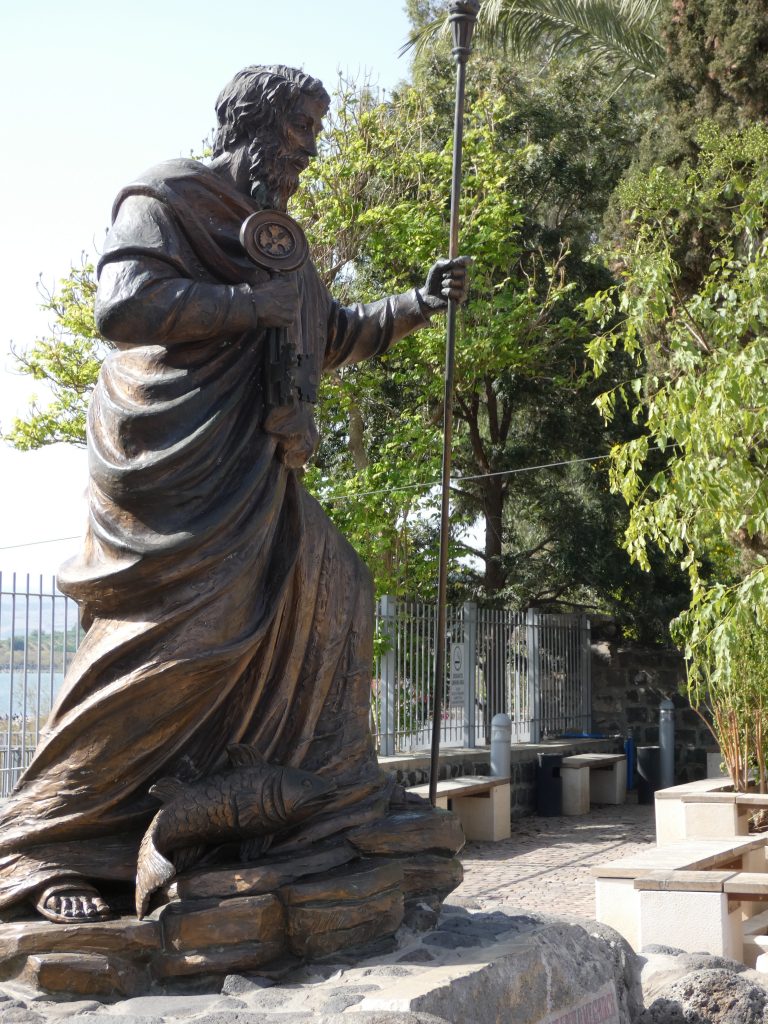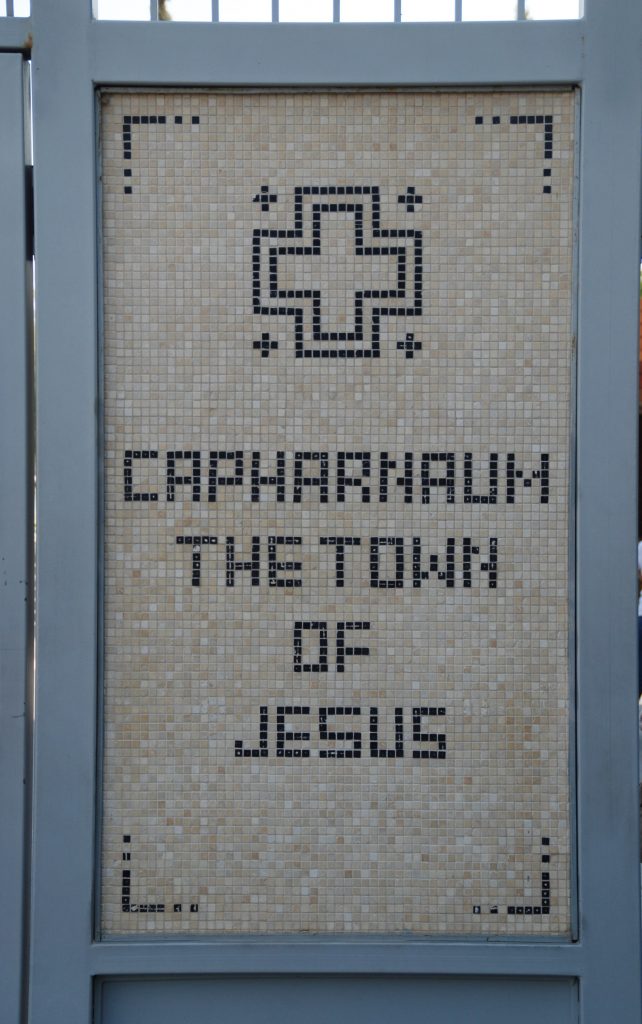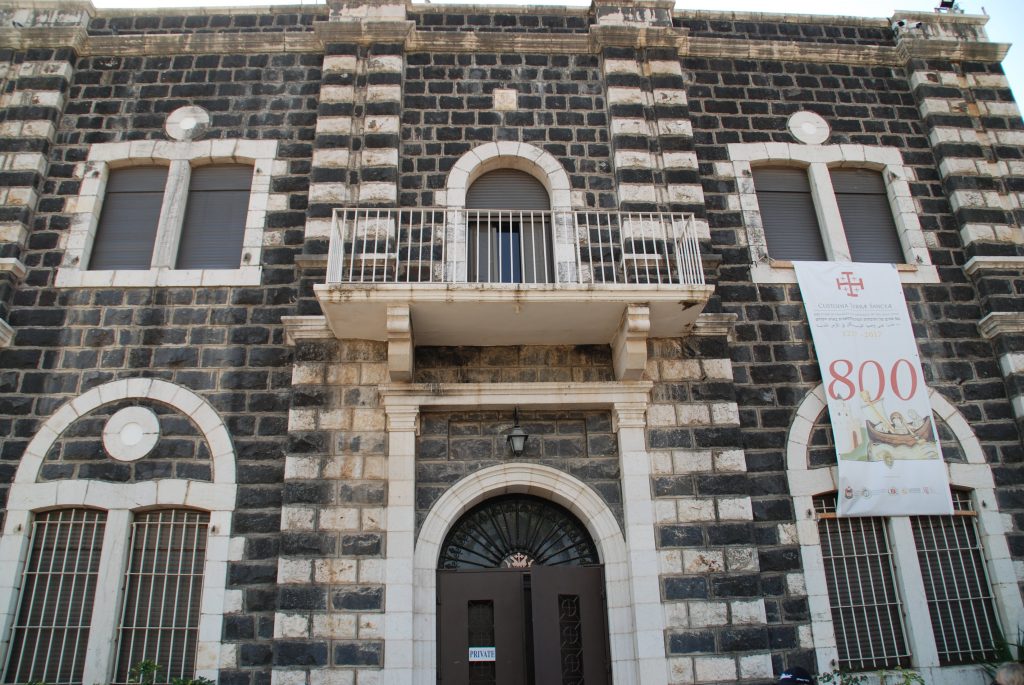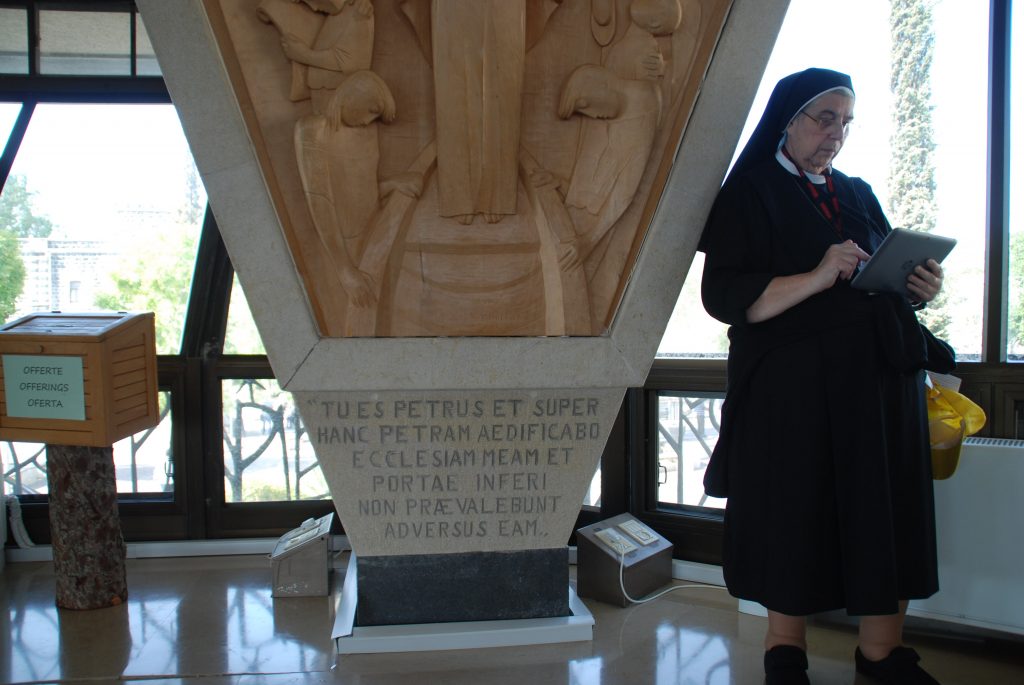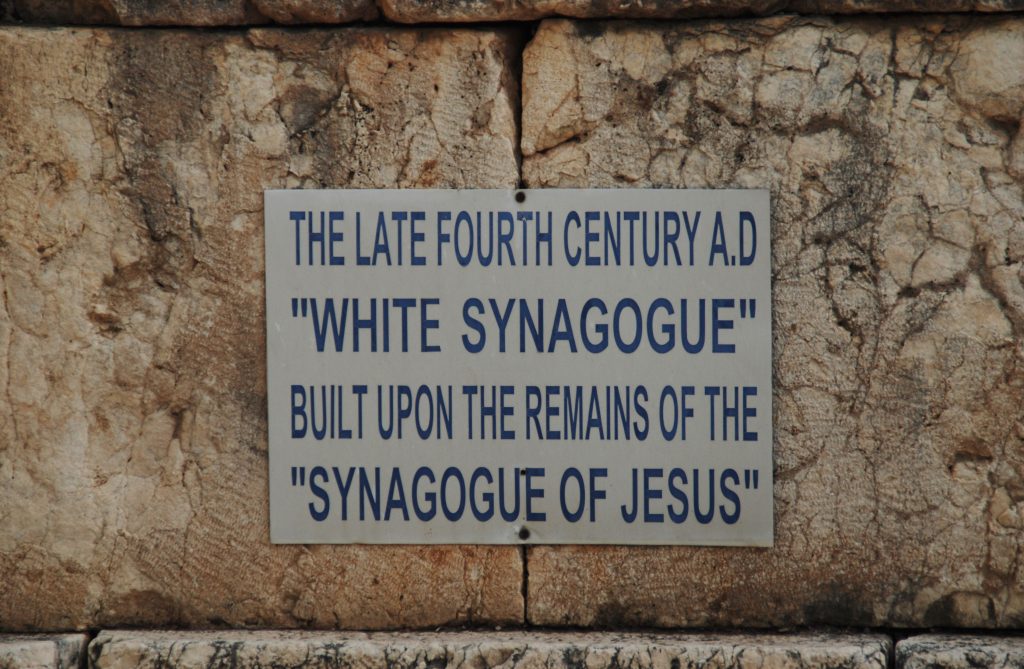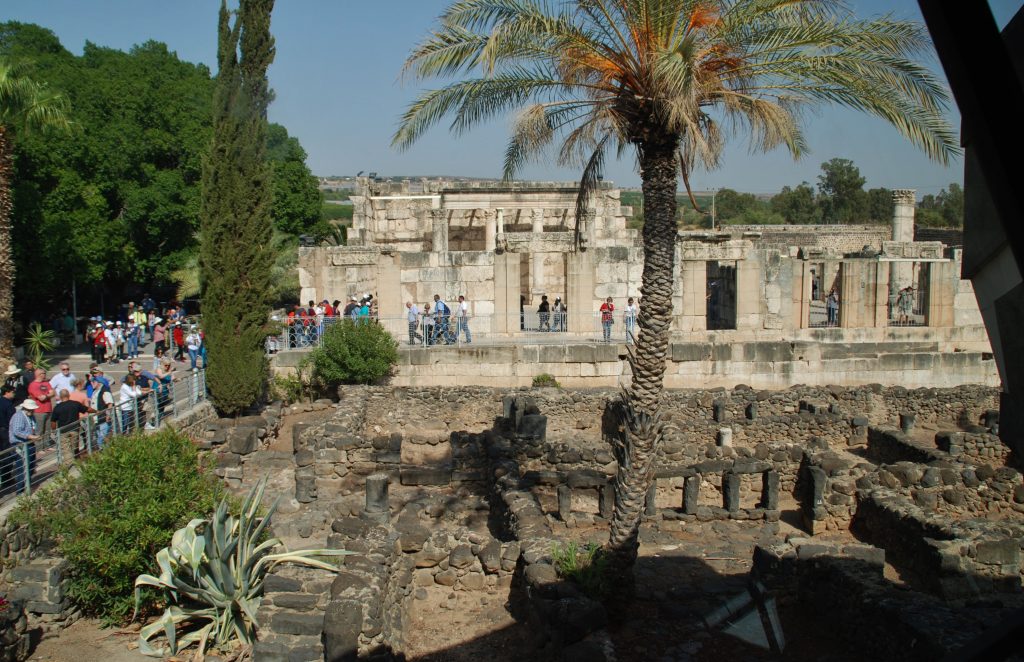
Although Jesus was born in Bethlehem, Capernaum became his home during the time of his ministry. Located on the northwest shores of the Sea of Galilee, this town was also home to some of Jesus’ disciples, Peter, Andrew, James, John and Matthew.
Stretching out over twelve acres, the ancient village of Capernaum was extensively excavated beginning in 1905. I could clearly see the private houses, separated into quarters which were built from dark volcanic basalt. Each home was similarly built to include the central courtyard, ovens, stairs leading to the roof, exits onto the street and an inner wall with low windows allowing light to enter from the courtyard.
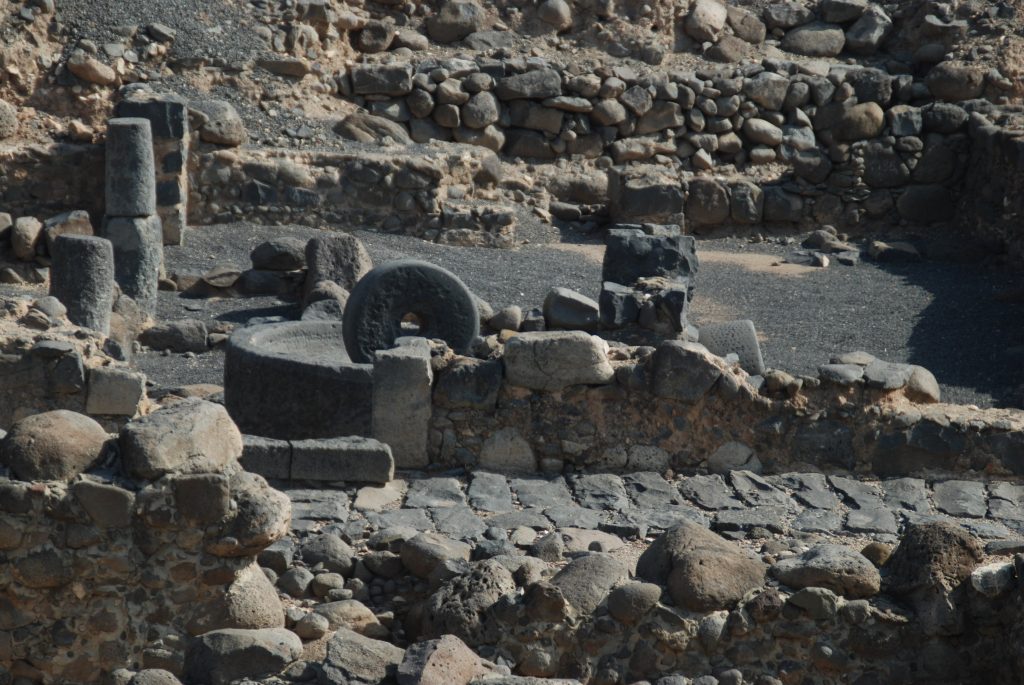
Archaeologists have found evidence that Capernaum was first established in the 2nd century BC during the Hasmonian period. Having a strong economic industry in fishing and agriculture of grain, wine and olive oil, this village is thought to have had a population of around 1,500. The seaside village of Capernaum also made a living collecting taxes (Matthew the Tax Collector) through its customs house (Matthew 9:9) and housed a small military garrison under the oversight of a centurion.
Most items uncovered were made of clay such as pots, lamps, amphoras and plates. In addition, there were several fishing related objects to include fishnets and weaving bobbins as well as wine and olive presses and mills for preparing grain.
The archaeological site is owned by two churches whereas the eastern side is owned by the Greek Orthodox with structures from the Byzantine and early Arab periods. The western section is under the control of the Franciscans which encompasses the remains of harbors, the synagogue, an octagonal church and a house which is claimed to be the home of apostle Simon Peter.
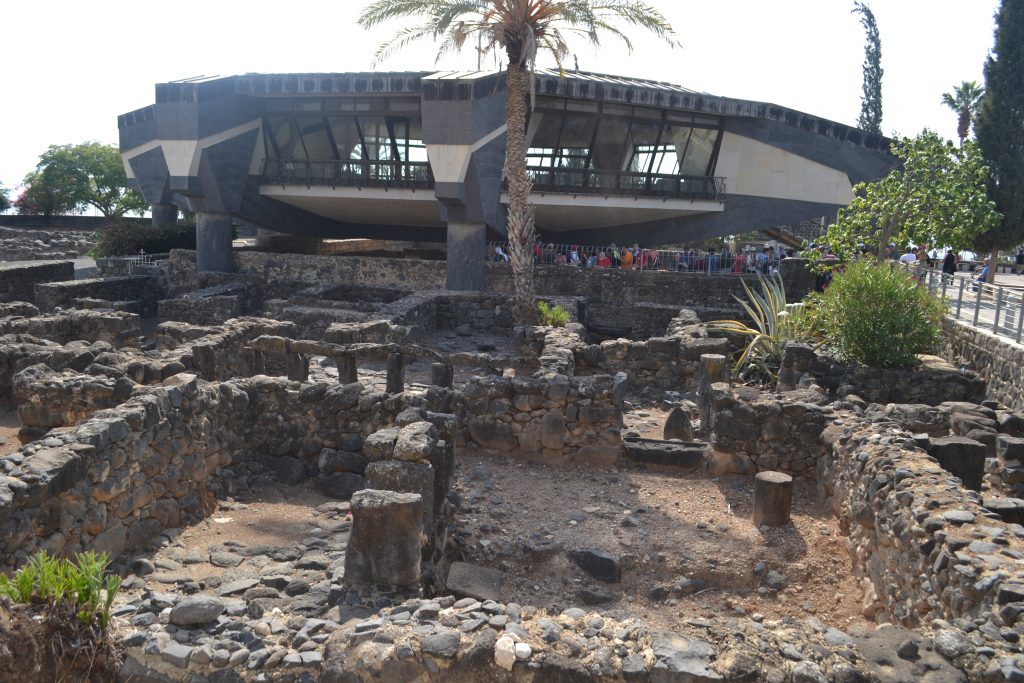
At the archaeological site of Capernaum is a spaceship-like memorial built over the home that is said to have been that of Saint Peter. During excavations, it was revealed that two ancient synagogues had been constructed one on top of the other to maintain the home as a memorial. Located between the White Synagogue and the Sea of Galilee, researchers have uncovered remains of first century homes that would have been built with wooden beams and thatched coverings. This would coincide with biblical references in the New Testament.
Peter’s family home is mentioned in the book of Mark in the Bible during the healing of the paralytic. “And when they could not come nigh unto him for the press, they uncovered the roof where he was and when they had broken it up, let down the bed wherein the sick of the palsy lay.” Mark 2:4
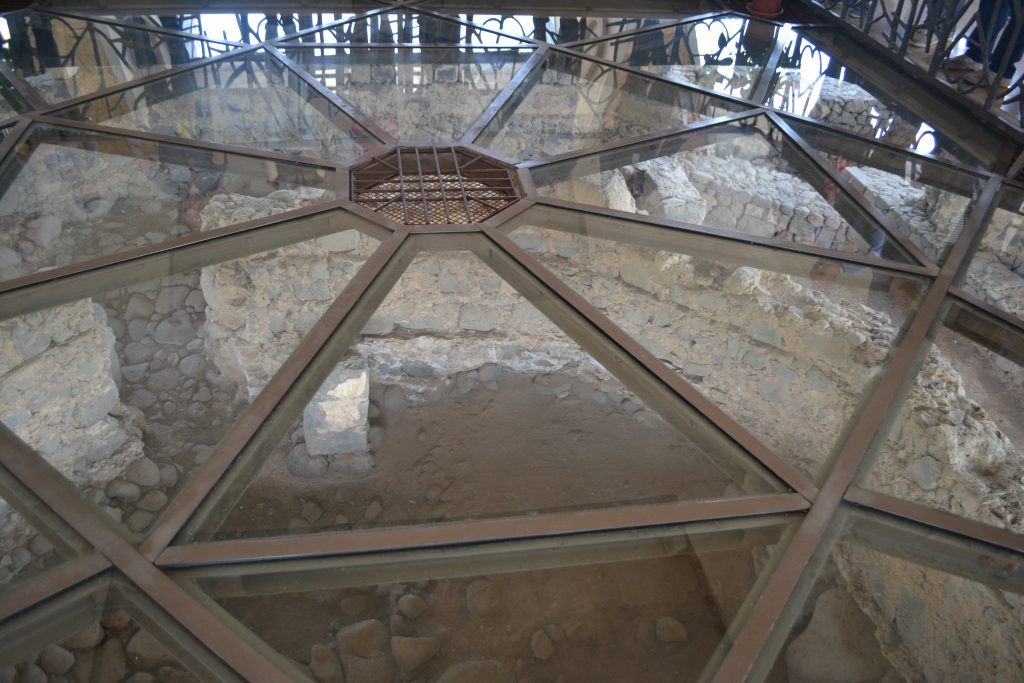
After a brief introduction to the site, we were provided time to explore Capernaum, so I began with a visit to the Catholic Church, dedicated in 1990. The layout includes an altar and seating area for Christian services, but the main attraction is the glass dome where visitors can look down on the 4th century Byzantine church and what remains of Simon Peter’s house.
The church was referenced in the writings of Egeria who was a pilgrim during the late 4th century AD. “Moreover, in Capernaum the house of the prince of apostles had been made into a church with its original walls still standing. It is where the Lord healed the paralytic.”
In front of the church is a beautiful bronze statue of Peter holding a large key which is a memorial for the visit of Pope John Paul II to Capernaum in March of 2000.

Beneath the Catholic Church lies a staging gallery where visitors can view the black basalt ruins of Simon Peter’s house buried under a mosaic floor and ancient remains of the basilica that had been built over it.
The characteristics of this house show that additional care was taken to preserve it over the years which has led archaeologists to believe this is, in fact, the house of Simon Peter. At the first century level of excavations, there were found normal domestic items of daily life in Capernaum. The structure above contained a large number of lamps suggesting it was used as a public gathering place or a house church. This room was also plastered and set apart from the other rooms where Christian pilgrims left inscriptions in Aramaic, Greek, Latin and Syriac, including a reference to Jesus as Messiah and Lord (Greek).
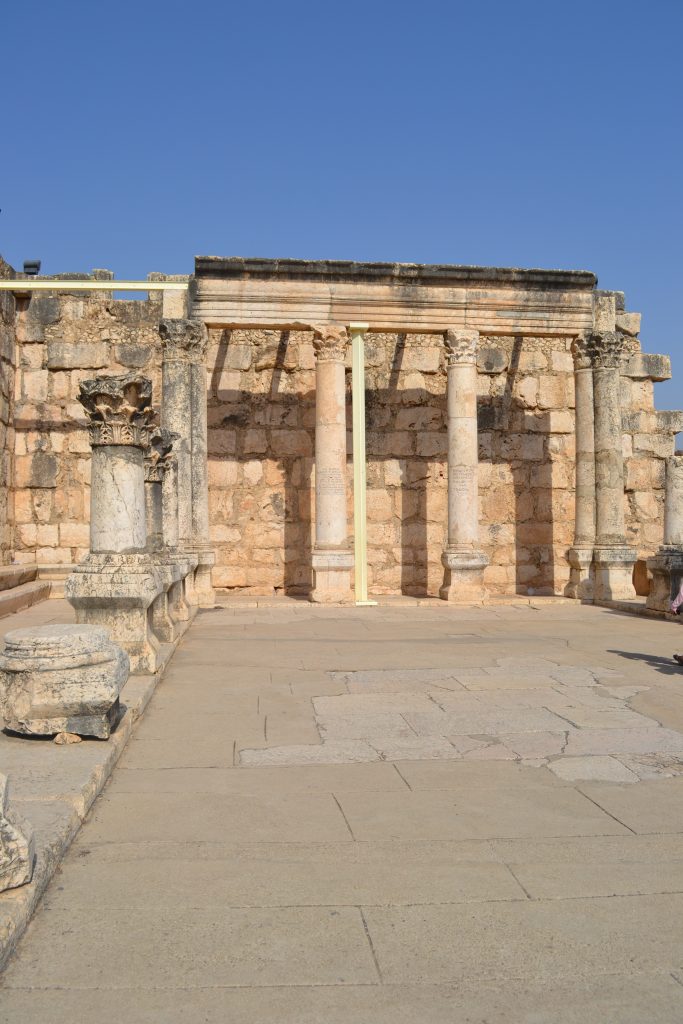
The White Synagogue stands out among the black volcanic structures of Capernaum and is one of the largest and famous of all excavated synagogues in Israel. Built with imported limestone, it sits on the site of the first century synagogue where Jesus first preached in the first century AD.
With large lavishly carved Corinthian columns, the structure included a basilica, a roofed courtyard and benches that skirted the entrance. Built around the 4th century AD, the plastered walls were decorated with beautiful reliefs that depicted Jewish religious traditions such as the menorah and ram’s horn. Decorating the frieze work was the astrological sign of the Capricorn, an image of a mythical sea horse. A set of stairs is thought to have led to a second story, which may have been a gallery where the women would congregate during a Jewish Sabbath service.
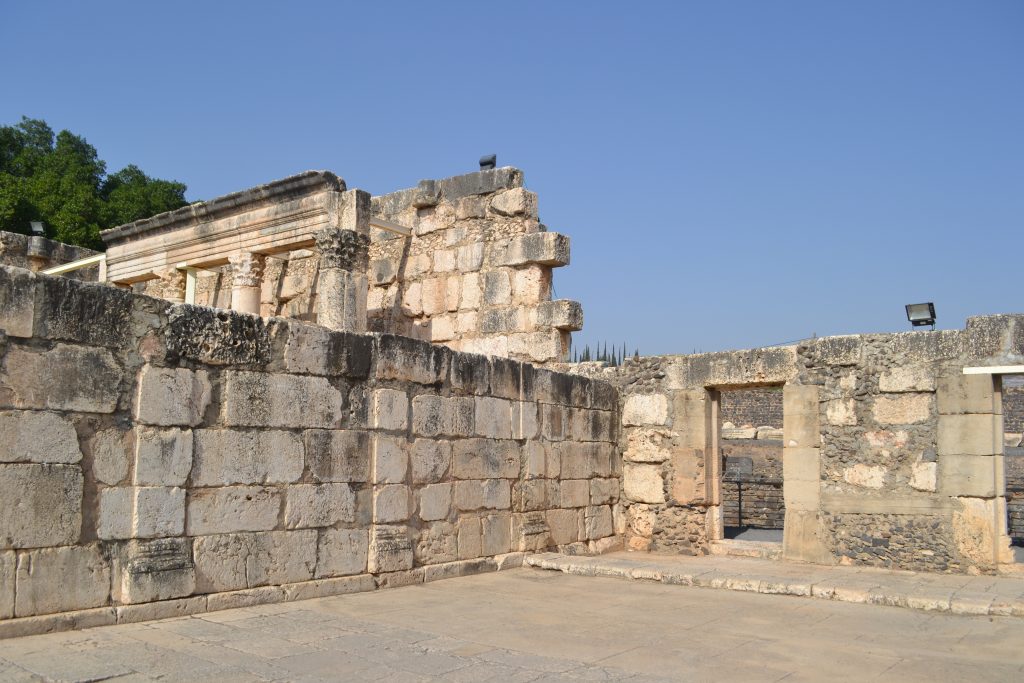
The basilica itself was similar in design to the one in Bar’am, but a little more elaborate to include a central prayer hall and a side room in addition to the courtyard and porch. The prayer hall’s south wall contained a storage area where the Torah scrolls were kept. It was towards this wall that the Jews would recite their prayers as this direction faced south towards Jerusalem. Two bemas were identified at the entrance where the scriptures were read, while children played games in the courtyard.

Several biblical references mention the town of Capernaum and Jesus performed many of his miracles in Capernaum.
In Scripture:
- Jesus makes his home in Capernaum: Matthew 4:12-17
- Jesus’ Miracles: Matthew 4:18 – 22, Mark 1:34
- Jesus heals the Centurian’s servant: Matthew 8:5 – 13, Luke 7: 1 – 10
- Jesus cures Peter’s mother-in-law: Matthew 8: 14 – 17 Mark 1:21-34, Luke 4:31 – 41
- Capernaum becomes Jesus’ “own town”: Matthew 9:1, Mark 2:1
- Jesus heals the man with palsy: Matthew 9:1 – 8, Mark 2: 1 – 12, Luke 5:17 – 26
- Mentions of Capernaum’s Roman garrison and tax/customs office: Matthew 9:9
- Jesus calls His disciples: Matthew 9:9-12, Mark 2:14, Luke 5:27
- Jesus raised the daughter of Jairus from the dead: Matthew 9: 18 – 26, Mark 5:22 – 43, Luke 8: 40 – 56
- Jesus healed the woman with the “issue of blood”: Matthew 9:20 – 22, Mark 5:25 – 34, Luke 8:43 – 48
- Jesus condemns Capernaum: Matthew 11:20-24, Luke 10:15
- Jesus healed the man with the withered hand: Matthew 12:9 – 14, Mark 3: 1 – 6, Luke 6:6 – 11
- Paying the temple tax: Matthew 17:24-27
- Jesus teaches in the synagogue: Mark 1:21 – 22, Mark 3:1, Luke 4:31 – 38, John 6:59
- Jesus cures a man possessed by the devil: Mark 1:21 – 28
- Peter and his brother Andrew in Capernaum: Mark 1:29
- Jesus cures a paralytic man: Mark 2:1-12
- Capernaum as entry point for travelers: Mark 3:35, Mark 5:1
- Roman centurion builds the temple: Luke 7:1 – 10
- Jesus is the “Bread of Life”: John 6:22-59
- Peter’s wife mentioned in I Corinthians 9:5

Capernaum has been one of the most significant pilgrimage stops for Christians and it was just as important to ancient travelers passing through on the Via Maris which connected Damascus to Egypt. Merchants would bring in silk and spices and trade them for Sea of Galilee fish and local fruit, such as figs. While a highway milestone marking the Via Maris continues to stand in Capernaum today, modern day pilgrims can sample the Jesus/St. Peter’s fish and abundant fruits and spices even today.
I couldn’t have been more thrilled to have made a stop in Capernaum on my Israel tour and highly recommend it as a day-trip from Tiberias. Have you had the opportunity to visit this amazing historical, seaside town? I would love to hear about the attractions you visited and the restaurants where you dined if you would kindly leave a message in the comments section below.
Many thanks for taking the time to read about my fabulous time in Israel and wishing you many Happy Travels!
What to See and What to Do:
Capernaum
Off Road 87
Kefer Nahum, Israel (locals may not recognize Capernaum)
Telephone: +053 28 40 991 or +052 88 58 421 Contact: Archimandrite Father Irinarchos
- Admission Fee: Adult and Children: 5 Israeli Shekel
- Hours: Summer Months from 10AM to 5:30PM; Winter Months from 10AM to 4PM; For groups contact Archimandrite Father Irinarchos at the number provided above.
- Amenities: Small café, historical and religious sites, restrooms, posted placards
- Scenic View: The spectacular view of Simon Peter’s house and a gorgeous view of the Sea of Galilee
- Length of Visit: 1 – 2 hours
- Travel Tip: Wear proper clothing as you may be turned away wearing shorts and tops with shoulders exposed. To reach Capernaum without a car, take a bus from Tiberias, and depart the bus at the Karie Deshe junction, and then walk the last 2 miles along the Sea of Galilee. Be advised that the locals, including the bus driver, won’t understand you if you ask for “Capernaum.” You need to say, “Kfer Nahum,” the Hebrew name for Capernaum that literally means the “Village of Nahum.”
Where to Stay:
Leonardo Club Hotel
Ha-Banim St 1
Tverya, 1420163 Israel
Telephone: +972 4 671 4444
Where to Eat:
Decks Restaurant
Gdud Barak St. 13
Tverya, Israel
Telephone: +972 4 671 0800
I ordered the St. Peter’s fish, which is a fried Tilapia filet that comes from the Sea of Galilee. AMAZING!
What to Eat:
- Kubbeh is similar to falafal in that it is served in a ball but made with meat and spices then deep fried.
- Manqusheh is similar to pizza made with flatbread topped with olive oil and spice (usually za’atar which is similar to thyme)
- Ka’ak is a large pretzel like pastry that is usually eaten at breakfast time. Crunchy on the outside and soft on the inside, they are readily available at bakeries and roadside stalls.
- Potato swirls are similar to french fries, cut and deep fried.
- Qatayef is a pancake-style dessert stuffed with cheese, nuts or sugar and spices and are popular during the Ramadan holiday
- Kunafeh is a pastry similar to baklava covered in syrup and cheese
What to Read:
- Khirbet Khizeh by S. Y. Yizhar
- The Hilltop, by Assaf Gavron
- Dancing Arabs by Sayed Kashua
- The People of Forever are Not Afraid, by Shani Boianjiu
- Five Seasons, by A.B. Yehoshua
- Twenty-One Stories by S. Y. Agnon
- Suddenly, A Knock on the Door by Etgar Keret
- Apples from the Desert, by Savyon Liebrecht
- From the Four Winds, by Haim Sabato
- To the End of the Land, by David Grossman
- A Tale of Love and Darkness, by Amos Oz
Photo Guide for Israel:
- The Western Wall for a religious experience
- Jaffa’s Old Town for its charm
- The Dead Sea for its interesting topography
- Caesarea Harbor and its Roman architecture and history are worth a visit
- Arbel National Park and Nature Reserve provides a phenomenal view of the Sea of Galilee
- The Church of the Holy Sepulchre in Old City Jerusalem is said to be the burial location of Jesus
- The view of the Temple Mount from the Mount of Olives
Disclosure: Please refer to our blog disclaimer tab for more information.
